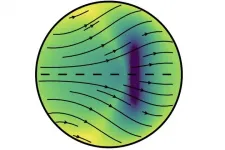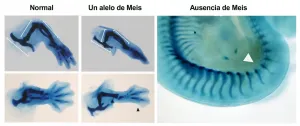(Press-News.org) Dogs may have earned the title "man's best friend" because of how good they are at interacting with people. Those social skills may be present shortly after birth rather than learned, a new study by University of Arizona researchers suggests.
Published today in the journal Current Biology, the study also finds that genetics may help explain why some dogs perform better than others on social tasks such as following pointing gestures.
"There was evidence that these sorts of social skills were present in adulthood, but here we find evidence that puppies - sort of like humans - are biologically prepared to interact in these social ways," said lead study author Emily Bray, a postdoctoral research associate in the UArizona School of Anthropology in the College of Social and Behavioral Sciences.
Bray has spent the last decade conducting research with dogs in collaboration with California-based Canine Companions, a service dog organization serving clients with physical disabilities. She and her colleagues hope to better understand how dogs think and solve problems, which could have implications for identifying dogs that would make good service animals.
To better understand biology's role in dogs' abilities to communicate with humans, Bray and her collaborators looked at how 375 of the organization's 8-week-old budding service dogs, which had little previous one-on-one interaction with humans, performed on a series of tasks designed to measure their social communication skills.
Because the researchers knew each puppy's pedigree - and therefore how related they were to one another - they were also able to look at whether inherited genes explain differences in dogs' abilities. Genetics explained more than 40% of the variation in puppies' abilities to follow human pointing gestures, as well as variation in how long they engaged in eye contact with humans during a task designed to measure their interest in people.
"People have been interested in dogs' abilities to do these kinds of things for a long time, but there's always been debate about to what extent is this really in the biology of dogs, versus something they learn by palling around with humans," said study co-author Evan MacLean, assistant professor of anthropology and director of the Arizona Canine Cognition Center at the University of Arizona. "We found that there's definitely a strong genetic component, and they're definitely doing it from the get-go."
At the time of the study, the puppies were still living with their littermates and had not yet been sent to live with a volunteer puppy raiser. Therefore, their interactions with humans had been limited, making it unlikely that the behaviors were learned, Bray said.
The researchers engaged the puppies in four different tasks. In one task, an experimenter hid a treat beneath one of two overturned cups and pointed to it to see if the puppy could follow the gesture. To ensure that the pups weren't just following their noses, a treat was also taped to the inside of both cups. In another version of the task, puppies watched as the researchers placed a yellow block next to the correct cup, instead of pointing, to indicate where the puppy should look for the food.
The other two tasks were designed to observe puppies' propensity to look at human faces. In one task, the researchers spoke to the puppies in "dog-directed speech," reciting a script in the sort of high-pitched voice people sometimes use when talking to a baby. They then measured how long the puppy held a gaze with the human. In the final task - a so-called "unsolvable task" - researchers sealed a treat inside a closed container and presented it to the puppy, then measured how often the puppy looked to the human for help opening the container.
While many of the puppies were responsive to humans' physical and verbal cues, very few looked to humans for help with the unsolvable task. That suggests that while puppies may be born knowing how to respond to human-initiated communication, the ability to initiate communication on their own may come later.
"In studies of adult dogs, we find a tendency for them to look to humans for help, especially when you look at adult dogs versus wolves. Wolves are going to persist and try to independently problem solve, whereas dogs are more likely to look to the social partner for help," Bray said. "In puppies, this help-seeking behavior didn't really seem to be part of their repertoire yet."
In many ways, that mirrors what we see in human children's development, Bray said.
"If you think about language learning, children can understand what we're saying to them before they can physically produce the words," she said. "It's potentially a similar story with puppies; they are understanding what is being socially conveyed to them, but the production of it on their end is probably going to take a little bit longer, developmentally."
MacLean said the next step will be to see if researchers can identify the specific genes that may contribute to dogs' capacity to communicate with humans.
"We've done some previous studies that show that dogs who tend to be successful as service dogs respond to people in different ways than dogs who aren't successful," MacLean said. "If you could identify a potential genetic basis for these traits, you might be able to predict, even before the puppy is born, if they are part of a litter that would be good service dog candidates, because they have the right genetic background. It's a long way down the road, but there is potential to start applying this."
INFORMATION:
(Toronto, June 3, 2021) -- The impact of deploying Artificial Intelligence (AI) for radiation cancer therapy in a real-world clinical setting has been tested by Princess Margaret researchers in a unique study involving physicians and their patients.
A team of researchers directly compared physician evaluations of radiation treatments generated by an AI machine learning (ML) algorithm to conventional radiation treatments generated by humans.
They found that in the majority of the 100 patients studied, treatments generated using ML were deemed to be clinically acceptable for patient treatments by physicians.
Overall, 89% of ML-generated treatments were considered clinically acceptable for treatments, ...
For reasons unknown, Earth's solid-iron inner core is growing faster on one side than the other, and it has been ever since it started to freeze out from molten iron more than half a billion years ago, according to a new study by seismologists at the University of California, Berkeley.
The faster growth under Indonesia's Banda Sea hasn't left the core lopsided. Gravity evenly distributes the new growth -- iron crystals that form as the molten iron cools -- to maintain a spherical inner core that grows in radius by an average of 1 millimeter per year.
But the enhanced growth on one side suggests that something in Earth's outer core or mantle under Indonesia is removing heat from the inner core at a faster rate than on the opposite side, under Brazil. Quicker cooling on one side would ...
Scientists at the Centro Nacional de Investigaciones Cardiovasculares (CNIC), working in partnership with researchers at the Institut de Recherches Cliniques de Montréal (IRCM) in Canada, have identified Meis transcription factors as essential biomolecules for the formation and antero-posterior patterning of the limbs during embryonic development.
In the study, published in Nature Communications, the research team carried out an in-depth characterization of the Meis family of transcription factors. Genetic deletion of all four family members showed that these proteins are essential for the formation of the limbs during embryonic development. "An embryo that develops in the absence of Meis does not ...
Regular strength and impact-type training may decrease or even prevent age-related bone deterioration in men, new research at the University of Jyväskylä, Finland, shows. The tibial bone properties of middle-aged and older male sprint athletes were followed over 10 years. The study presents novel findings on maintaining the adaptability of the aging skeleton and on the importance of regular intensive training for maintaining bone health.
"Part of the age-related bone loss is probably explained by reduced levels of physical activity. Especially intensive, bone-loading exercise ...
Affecting more than one in a hundred children, autism spectrum disorder is one of the most common neurodevelopmental disorders. It has a particular impact on social interaction, including difficulties in understanding other people's perspectives, beliefs, desires and emotions, known as 'theory of mind'. Bilingual families with an autistic child often tend - and are sometimes encouraged - to forego the use of one of the home languages, so as not to further complicate the development of their child's communicative skills. A researcher from the University of Geneva (UNIGE, Switzerland), in collaboration with the Universities ...
So-called quantum dots are a new class of materials with many applications. Quantum dots are realized by tiny semiconductor crystals with dimensions in the nanometre range. The optical and electrical properties can be controlled through the size of these crystals. As QLEDs, they are already on the market in the latest generations of TV flat screens, where they ensure particularly brilliant and high-resolution colour reproduction. However, quantum dots are not only used as "dyes", they are also used in solar cells or as semiconductor devices, right up to computational building blocks, the qubits, of a quantum computer.
Now, a team led by Dr. Annika Bande at HZB has extended the understanding of the interaction between several quantum dots with an ...
A biomarker in the blood of patients with bowel cancer may provide valuable insight into the risk of cancer relapse after surgery and the effectiveness of chemotherapy.
Research published in PLOS found circulating tumour DNA (ctDNA) measured before and after surgery provided a reliable marker for predicting whether the cancer would recur following chemotherapy treatment.
The ctDNA also provided a real-time measure of the effectiveness of chemotherapy, highlighting the potential for this test to provide an early indication of the success of chemotherapy in eradicating microscopic cancer.
At a glance
By measuring levels of ctDNA present in the blood of bowel cancer patients after surgery, researchers were able to predict the likelihood ...
If insomnia keeps you awake at night, Flinders University researchers recommend a trip to the doctor - not for a sleeping pill prescription but for a short course of intensive behavioural therapy.
Researchers have developed new clinical guidelines for Australian doctors to give family GPs insights into the most effective treatment for insomnia - Cognitive Behavioural Therapy for insomnia (or 'CBTi').
CBTi improves insomnia, mental health and quality of life, and can be more successful than sleeping pills, say Adelaide Institute for Sleep Health (AISH) sleep experts from Flinders University in a new paper in the Australian Journal of General Practice.
Most patients with insomnia managed in general practice are prescribed potentially addictive ...
Paleo researcher Charlotte Prud'homme, who until recently worked at the Max Planck Institute for Chemistry and is now a researcher at the Université Lausanne, explains: "The 80-meter-thick sedimentary sequence we found at Charyn Canyon in southeast Kazakhstan provides us with a virtually continuous record of five million years of climate change. This is a very rare occurrence on land!" The alternating dust and soil layers provide the first reliable evidence, in one place, of long-term interactions between major climate systems on the Eurasian continent. "Over the past five million years, the land surfaces of Eurasia appear to ...
The so-called 'bullshit jobs theory' - which argues that a large and rapidly increasing number of workers are undertaking jobs that they themselves recognise as being useless and of no social value - contains several major flaws, argue researchers from the universities of Cambridge and Birmingham.
Even so, writing in Work, Employment and Society, the academics applaud its proponent, American anthropologist David Graeber, who died in September 2020, for highlighting the link between a sense of purpose in one's job and psychological wellbeing.
Graeber initially put forward the concept of 'bullshit jobs' - jobs that even those who do them view as worthless - in his 2013 essay ...







